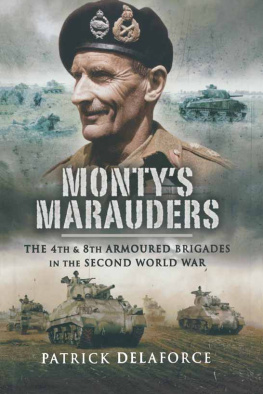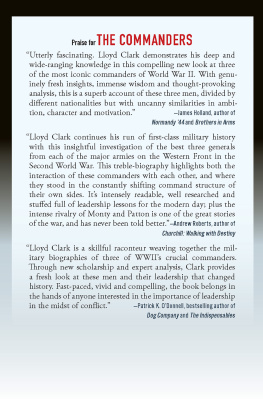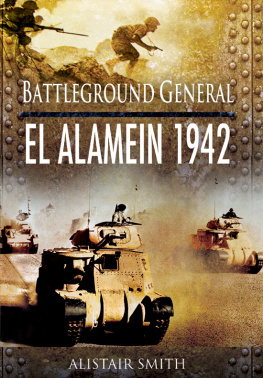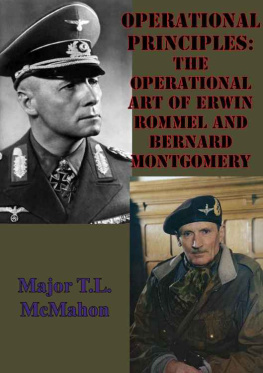This edition first published in the United States in 2012 by
The Overlook Press, Peter Mayer Publishers, Inc.
141 Wooster Street
New York, NY 10012
www.overlookpress.com
For bulk and special sales, please contact
Copyright 2011 by Peter Caddick-Adams
All rights reserved. No part of this publication may be reproduced or transmitted in any form or by any means, electronic or mechanical, including photocopy, recording, or any information storage and retrieval system now known or to be invented, without permission in writing from the publisher, except by a reviewer who wishes to quote brief passages in connection with a review written for inclusion in a magazine, newspaper, or broadcast.
ISBN 978-1-46830-089-5
To Stefania and Emmanuelle for their
love, support and tolerance in allowing me to
spend so much time with the field marshals.
Contents

There was rarely a quiet moment in the Ypres area, which witnessed near-continuous fighting, from October 1914 to October1918. Monty was dangerously wounded in Mteren in 1914, and from 191718 he planned operations as a staff officer with IXCorps in the battlefields east of Ypres. Within the Ypres salient are the villages of Gheluvelt and Messines, where AdolfHitler fought, and Ploegsteert, where Lt.-Colonel Winston Churchills battalion (6/Royal Scots Fusiliers) was stationed betweenJanuary and May 1916.

Named after a river that most British troops never got to see, the Somme battlefields witnessed Montys presence twice. Initiallyduring the Great Push of 1916, whose slow progress is charted here, Bernards 104th Brigade fought in the area of TrnesWood, Malz Horn Farm and Guillemont. His advance with 47th Division in 1918 is also shown, including Happy Valley, where hisbrigade paraded in 1916, but which his division attacked in 1918.

Rommels 1917 war in Italy was one characterised by speed and movement, in contrast to the static nature of the Western Front.Erwin advanced 150 miles over twenty-two days, ending spectacularly on the River Piave, at Longarone, on 10 November. Hisachievement is all the more impressive when one remembers that most of it was conducted in contact with the enemy, over tiringmountainous terrain and on foot.

The armoured counter-attack against 7th Panzer Division at Arras was the first time Rommel encountered British troops. Deployingfrom Vimy, the Royal Tank Regiments Matildas completely surprised disorganised German units; only the speedy use of artillery at Telegraph Hill and Wailly saved 7th Panzerdivision from annihilation. Caught in the midst of the fracas, Rommel was left with an indelible impression of British resourcefulness.

Historians agree that of all British formations which fought in 1940, Montys 3rd Division performed best. It trickled intothe Dunkirk perimeter whilst fighting rearguard actions to slow the German advance, before rescue from the beaches or port.Dunkirk also witnessed Montys elevation from divisional to corps command, when his boss (Brooke) departed for England.

It was 7th Panzer Divisions dramatic progress through northern France in 1940 that brought Rommel national acclaim throughoutGermany, a Knights Cross and led directly to his North African posting. He covered over 500 miles in forty days with battleson the River Meuse and at Arras and the capture of Cherbourg on 19 June.

The advances and retreats of both sides in North Africa took place over huge distances, underlining how success rested onefficient logistics. All supplies had to be imported by air or sea and trucked to the battlefields. The campaign had a see-sawnature at the operational level, and Rommel came very close to his goals of Cairo and the Suez Canal.

As well as numerical superiority, some of Montys success at El Alamein was due to his ability to deceive his opponents intobelieving that Eighth Armys strike would come from the south. At this stage the Afrika Korps were 700 miles from their nearestport, Benghazi, and 1,400 miles from Tripoli, whilst Cairo for the British was a mere 150 miles east by road or rail.

Caen dominated the eastern sector of the Normandy battlefield. Failure to seize the city on D-Day necessitated a series offrustrating and attritional operations, each of increasing size, in an effort to fight in more favourable terrain and breakout of the bridgehead. Note the proximity of Montys headquarters to the battle zone, whereas Rommels headquarters was ahundred miles east, at La Roche Guyon.

Considering that the bulk of Allied forces were still around Falaise on 21 August, their subsequent breakout was conductedwith great speed. Rheims was liberated on 30 August, Arras and Mons on 2 September, Brussels the following day, Charlevilleon 4 September and Ypres two days later. Once the Normandy front collapsed there were few German reserves to stem the extremelyrapid advance, sometimes dubbed Montys Blitzkrieg.
At every crossway on the road to the future, each progressive spirit is opposed by a thousand men appointed to guard the past.
Count Maurice de Maeterlinck
I T IS MID-AFTERNOON ON 21 May 1940, a warm Tuesday, near Arras in northern France. Last year, the scaffolding came down, ending years of reconstruction.The Great War had seen Arras shelled mercilessly. Now it looks like happening all over again.
The same grey-clad invaders are once more at the gates. One of them, an officer who had done well in the previous conflict,is now a divisional commander. The sun catches the unique bauble Generalmajor Erwin Rommel wears at his throat, the Pour le Mrite. His business is reducing attrition. Not in avoiding combat, but by superior tactics which will limit the fighting. Usingtanks at high speed, and lots of them, he aims to slice through his opponents lines before they know whats happened. Sofar he has succeeded beyond his wildest expectations. The forty-eight-year-old took over his command just two months earlier,when his men were still in training. Now they are further into France than any of their fellow invaders, and have become knownas the Ghost Division for their wraithlike ability to materialise anywhere on the battlefield.




















